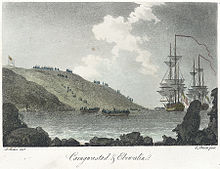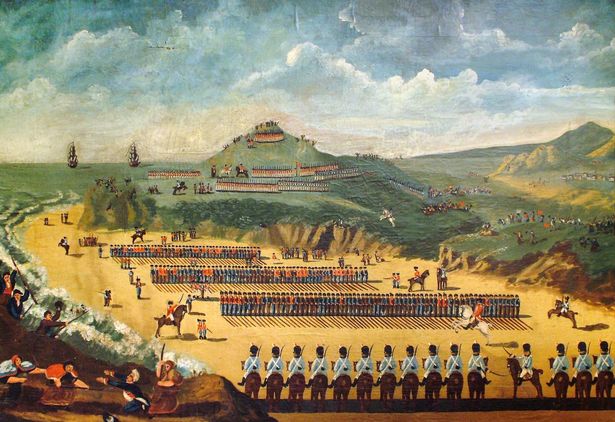The Last Invasion of Britain – The Battle of Fishguard
22nd February 1797
The French Revolution that started in 1789 and continued to the end of that century was the catalyst for the last time mainland Britain was invaded by a foreign army. The Revolutionary zeal that flowed from France was re-directed across Europe in the 1st Coalition War of 1792-1797. The 2nd Coalition War that followed in 1798 lasted until 1802 and went further afield.
The anti-monarchy feeling that led to the execution of Louis XVI in January 1793 caused the French to launch an attack on both Ireland and Great Britain in the hope of stirring up the working classes against their masters and ridding Europe of another monarchy. The plan seemed simple. General Hoche would invade Ireland with a force of 15,000. This would lead to an uprising in Ireland against British rule that had been in place since the days of Oliver Cromwell 150 years before. The French knew that the British would react and mobilise a force to fight back. Therefore it planned two diversionary attacks. One would land in the Northeast and make its way to Lancashire whilst the second would land in the Southwest, or Wales, and march North to Chester. In both these cases the working men of Britain, seeing what had happened in revolutionary France, would seize their moment and join the French forces.
The main force set sail in December 1796 and arrived in Bantry Bay. Severe storms battered and scattered the fleet. The remains of that fleet managed to limp home to Brest harbour. The attack in the Northwest suffered a similar fate. The only successful invasion was in the south where William Tate, an Irish-American, veteran of the American War of Independence, led the army. He had fled to Paris after he had failed to capture New Orleans but was seen as just the man to lead this expedition. He had with him ‘La Seconde Legion’ or ‘La Legion Noir’, the Black Legion, named after their dark uniforms. This unit comprised of 600 regular troops and a regiment of deserters, convicts and royal prisoners. They were transported in four ships, the two biggest being La Vengeance and La Resistance. These were the largest and newest in the French fleet, the latter being on her maiden voyage. The commander of the fleet was Commodore Castagnier and he flew the Russian flag as he neared the Bristol Channel. As they approached Porlock it became apparent that a landing in Bristol was out of the question. The tides and winds made it quite impossible. They had been asked to burn Bristol to the ground as part of their quest to cause as much chaos as possible, dislocate British trade and encourage the working classes to rebel.
 They therefore sailed to target B. As they passed Ilfracombe the residents raised the alarm but the four boats continued and rounded St. David’s Head, now with the British flag raised, and headed for Cardigan Bay. They tried to land at Fishguard harbour but the guns from the fort managed to stop their entrance and they were forced to land at Carregwasted Head, three miles away on February 22nd.
They therefore sailed to target B. As they passed Ilfracombe the residents raised the alarm but the four boats continued and rounded St. David’s Head, now with the British flag raised, and headed for Cardigan Bay. They tried to land at Fishguard harbour but the guns from the fort managed to stop their entrance and they were forced to land at Carregwasted Head, three miles away on February 22nd.
Tate advanced inland and captured a number of farms as well as the high ground at Garnwnda and Carngelli that gave him a good view across the area. He set up his headquarters at Trehowel Farm. Whilst the regular soldiers behaved with a sense of decorum the irregulars showed massive ill discipline. They started drinking the alcohol from the farms they had looted, got drunk, refused to fight and deserted. They also broke into the church of St. Nicholas and burnt the bibles. Rather than encouraging the native Welsh to turn on their English masters it had the opposite effect. They were outraged.
The Welsh started fighting back. William Tate, a former Under-Secretary of State, who had held land in America before Independence, had purchased an estate in Pembrokeshire. His mansion was at Llanstinan. He had formed the Fishguard and Newport Volunteer Infantry in 1794 and he put his son, Thomas, in charge despite the fact that he had no previous military experience. He would have 300 men at his disposal when all were present. Meanwhile under Commander Colby there were 200 men in the Cardiganshire Militia and these were mustered at Haverfordwest where they had been on exercise. The third group, under the leadership of Lord Cawdor, were the Pembroke Yeomanry Cavalry. They linked up with Colby and moved towards Fishguard.
Knox had told Colby that, unless completely outnumbered, he would attack the French on February 23rd. However 100 of his men had yet to arrive and his estimate of the French force was 1500. He did not realise that many of these were deserting and retreated quickly. Knox then met up with Colby and Lord Cawdor, who, despite much chagrin on the part of Knox, assumed control. The combined force marched on Fishguard and Cawdor’s HQ was set up in The Royal Oak, Fishguard Square.
Tate still outnumbered the British having over 800 men, gunpowder, grenades and guns. However he soon learnt that his naval support had disappeared. They had slipped their anchors as news of Royal Navy ships on the horizon spread. Indeed La Resistance was captured and was later renamed HMS Fisguard, which is the correct spelling. Without Welsh support he had no choice but to negotiate and he sent two officers to the Royal Oak to speak to Cawdor.
Cawdor bluffed about the size of his force and demanded an immediate and unconditional surrender, ordering Tate to assemble his men the following morning, 24th, on Goodwick Sands by 10am or else he would attack.
 On the 24th the British soldiers lined up along the sand. The townsfolk watched from the cliffs above in their traditional Welsh costumes. To the French the large black hats they wore made them look like Grenadier Guards. Rumour has it that one Welsh woman, Jemima Nicholas, went down onto the beach armed with a pitchfork and single-handedly ‘persuaded’ 19 French soldiers to lay down their arms. Tate, after trying to delay, got his soldiers to pile their arms on the beach and they were marched away to captivity. Most of them, including Tate, were eventually held at Portsmouth but they did not stay long. The following year they were traded for English soldiers and returned to France. The last that was heard of Tate was in 1809 and it is thought he returned to America.
On the 24th the British soldiers lined up along the sand. The townsfolk watched from the cliffs above in their traditional Welsh costumes. To the French the large black hats they wore made them look like Grenadier Guards. Rumour has it that one Welsh woman, Jemima Nicholas, went down onto the beach armed with a pitchfork and single-handedly ‘persuaded’ 19 French soldiers to lay down their arms. Tate, after trying to delay, got his soldiers to pile their arms on the beach and they were marched away to captivity. Most of them, including Tate, were eventually held at Portsmouth but they did not stay long. The following year they were traded for English soldiers and returned to France. The last that was heard of Tate was in 1809 and it is thought he returned to America.
The invasion was over. There would be plenty more attempts by the French and the Germans but all were unsuccessful. Many argue that there have been cultural invasions and immigration invasions since then but never an armed one - yet. In 1853 the Pembroke Yeomanry gained the battle honour “Fishguard” that is unique as they are the only regiment in the British Army that bears the name of an engagement on British soil. This little known invasion, rarely mentioned in the textbooks, was over really before it had begun.


